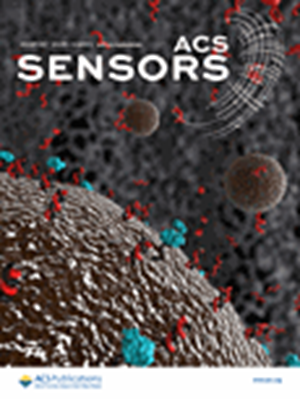氮掺杂石墨炔作为人体呼吸中挥发性有机物传感材料的研究进展
IF 9.1
1区 化学
Q1 CHEMISTRY, ANALYTICAL
引用次数: 0
摘要
利用密度泛函理论和非平衡态格林函数方法,研究了二维掺氮石墨烯(N-GY)与挥发性有机化合物(乙醇、乙二醇、丙酮和甲苯)之间的相互作用,并探讨了 N-GY 在传感人体呼出的挥发性生物标记物方面的潜在应用。N-GY 是一种直接带隙半导体,带隙宽度为 0.408 eV。导带底部和价带顶部均位于 Γ 点。所有目标挥发性有机化合物(VOC)都处于物理吸附状态。为了验证 VOCs 的传感机制,分析了 Bader 电荷转移、吸附距离、功函数、电子局域函数、电荷密度差、能带结构和状态密度。同时,利用 NEGF 方法计算了 VOCs 分子吸附前后的 I-V 关系。结果表明,在扶手方向 0.5 V 偏置电压下,N-GY 能很好地区分四种气体分子,其中对丙酮的灵敏度最高,达到 81%。因此,N-GY 单层是分析人体呼出的挥发性有机化合物以及糖尿病早期筛查的潜在候选材料。本文章由计算机程序翻译,如有差异,请以英文原文为准。

Nitrogen-Doped Graphyne as a Promising Material for Sensing Volatile Organic Compounds in Human Breath
Using density functional theory and the nonequilibrium Green function method, the interaction between two-dimensional nitrogen-doped graphyne (N-GY) and volatile organic compounds (ethanol, ethylene glycol, acetone, and toluene) was investigated, and the potential application of N-GY for sensing volatile biomarkers exhaled by human breath was explored. The N-GY is a direct band gap semiconductor with a band gap width of 0.408 eV. The bottom of the conduction band and the top of the valence band are both located at the Γ point. All target volatile organic compounds (VOCs) are in physical adsorption states. In order to verify the sensing mechanism of VOCs, Bader charge transfer, adsorption distance, work function, electron localization function, charge density difference, energy band structure, and density of states were analyzed. At the same time, the I–V relationship of VOCs molecules before and after adsorption was calculated by using the NEGF method. The results show that at 0.5 V bias voltage under the armchair direction, N-GY can well distinguish four gas molecules and has the highest sensitivity for acetone with a sensitivity of 81%. Therefore, the N-GY monolayer is a potential candidate material for analyzing VOCs exhaled by the human body as well as for early screening of diabetes.
求助全文
通过发布文献求助,成功后即可免费获取论文全文。
去求助
来源期刊

ACS Sensors
Chemical Engineering-Bioengineering
CiteScore
14.50
自引率
3.40%
发文量
372
期刊介绍:
ACS Sensors is a peer-reviewed research journal that focuses on the dissemination of new and original knowledge in the field of sensor science, particularly those that selectively sense chemical or biological species or processes. The journal covers a broad range of topics, including but not limited to biosensors, chemical sensors, gas sensors, intracellular sensors, single molecule sensors, cell chips, and microfluidic devices. It aims to publish articles that address conceptual advances in sensing technology applicable to various types of analytes or application papers that report on the use of existing sensing concepts in new ways or for new analytes.
 求助内容:
求助内容: 应助结果提醒方式:
应助结果提醒方式:


